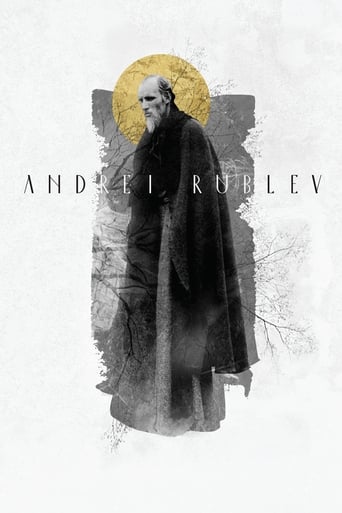jovana-13676
Where do I begin? The wonderful B&W photography, the hypnotic camera movement, the incredible production design, the cruelty that this beauty finally depicts; Tarkovsky is an Orthodox saint. Here's a proof that god lives in arts and art is in the cinema. This is a masterpiece on pair with its subject's works. Tarkovsky is Rublev.
Poshlust
It's not a biography by any means, it's largely fiction - it's only loosely based off Rublev's life. The film focuses more on his dedication to Eastern Orthodoxy, as well as its role in his evolution as an artist. There are certain characters that each represent different philosophical outlooks under a single unanimous religious belief. In particular, Theophanes is an interesting take on someone being God-loving yet simultaneously overly cynical in his repulsion by His man's vile nature. Outside of characters, the story is alright. The second half is mostly boring in my opinion. Being shot in black and white to emphasize the colorful ending - no doubt to add "life" to the conclusion - is kind of gimmicky, but otherwise a decent film.
deickos
Bergman wrote in his autobiography, this is the best film ever made and I find it very difficult to disagree. After watching Tarkovsky's films one cannot be the same person unless he is completely dry inside. I can find so few films that can stand beside Andrei Rublev! and many of them are again Tarkovsky's! We are so grateful for all this man left us - and it is only 7 films. Others would make dozens and would not reach Tarkovsky even if they lived a thousand years. The distances inside this man's work are simply immense.
George Roots (GeorgeRoots)
An epic that succeeds in all of its three hours (I say this because several versions exist), Tarkovsky's preferred vision stands as one of the greatest Russian movies ever made. Because only little is known of Andrei Rublev's life, a heavier focus is made on the hardships and violence of medieval Russia. In doing so the film can approach themes such as artistic freedom, religion and (Ironically) repressive authority (As the film was banned in the Soviet Union, until a few years later when they released a censored version).Though it strangely begins with an unexpected hot air balloon ride, surprisingly in these few short minutes the film has featured many of the themes that will be present throughout the picture, such as life and creative hopes dashed. Religious icon painter Andrei Rublev (Anatoly Solonitsyn, in the first of many Tarkovsky productions), and other wandering monks seek work as they travel across the fields and treacherous landscapes of 15th century Russia. Ever the observer, Rublev is forced to hear the arrogance and shortcomings of his companions, as well as the locals whose lifestyles can be seen as sinful to others, and will eventually fall to the wrath of Prince's and Tartars. It's a long narrative where more hopes are crushed than realised, but ultimately depicts the violence and hardships of the time effortlessly.I've come to respect that the film's focus switches from Rublev and his surroundings, as the cinematography and shots that Andrei Tarkovsky and Vadim Yusov employ just blend the multiple narratives seamlessly. As for music I can only really remember the last 6 or so minutes of the film, but the hundreds of extra's, set pieces and moments I don't want to spoil has its own kind of musical rhythm. The recurring themes are ever present, and the early moments of Tarkovsky's references to classic paintings start here (Such as "A detail of The Hunters in the Snow" (1565) by Pieter Bruegel the Elder, though it features much more prominently in "Solaris", 1972). Of course there is the small amount of infamous animal abuse of a cow and a horse, but I also sternly believe that it was kept to a minimum and handled very well given that the cow was covered in asbestos, and the horse was heading to the slaughterhouse regardless (Trust me, it really isn't all that terrible considering some other movies).Final Verdict: Actions speak louder than words in "Andrei Rublev". Whilst not deeply ambiguous, it certainly fulfils an artistic purpose that never comes off as arrogant. It is as epic and grand as the paintings themselves, and whilst not my favourite of his works it could most definitely be Tarkovsky's masterpiece. 9/10.





